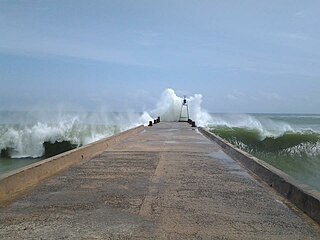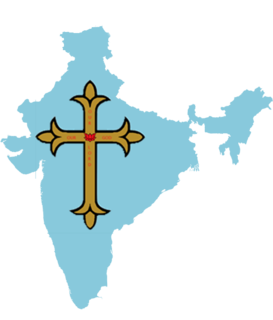
There are two forts named Udayagiri Fort in South India.

There are two forts named Udayagiri Fort in South India.
Udayagiri Fort in Andhra Pradesh was constructed by Langula Gajapathi, chieftain to Gajapatis of Odisha approximately between 1434 and 1512 CE.

The fort in Tamil Nadu is located 14 kilometres (8.7 mi) from Nagercoil in Thuckalay Town, Kanyakumari District on the Thiruvananthapuram-Nagercoil National highway at Puliyoorkurichi. This was the most important military barracks of the rulers, when Padmanabhapuram was their capital.
Originally built in the 17th century, the fort was rebuilt by Maharaja Marthanda Varma of Travancore in the 18th century.
Enclosing an area of about 90 acres (36 ha), including an isolated 260 feet (79 m) hillock. The fort contains an old foundry which was used for casting guns.
The fort was rebuilt during the reign of Marthanda Varma, between 1741-44 under the supervision of Eustachius De Lannoy, a Flemish naval commander of the Dutch East India Company, who later served as the Chief of the Travancore Army. [1]
In the early days, the fort was of strategic importance. Prisoners captured in the campaign against Tippu Sultan were confined in the fort for some time. In 1810, the East India Company's Army under Colonel Leger marched into Travancore through the Aramboly Pass (Aralvaimozhi) to quell a rebellion under the leadership of Velu Thambi Dalava.
In later years, English East India Company troops were stationed at the fort until the middle of the 19th century. A foundry for the manufacture of guns, mortars, and cannonballs was established within the fort under the supervision of the resident General.

The fort is built of massive granite blocks around an isolated hillock.
The tombs of the Dutch Admiral Eustachius De Lannoy, (in whose honour the fort was once called Dillanai Kottai— De Lennoy's Fort), and of his wife and son can still be found inside a partly ruined chapel in the fort.
De Lannoy's body was buried within the fort and a chapel was built at his burial site. De Lannoy's tombstone lies within the walls of the ruined chapel. The inscriptions on his stone are both in Tamil and in Latin. His wife and son were buried by his side.
Recently, officials of the Department of Archaeology found a tunnel within the fort.
Presently, the fort has been turned into a bio-diversity park by the Tamil Nadu forest department, with sites of historical importance, such as De Lannoy's tomb, remaining as protected archaeological sites under the Archaeological Department of India. [2]

The Kingdom of Travancore (/ˈtrævənkɔːr/), also known as the Kingdom of Thiruvithamkoor, was an Indian kingdom from c. 1729 until 1949. It was ruled by the Travancore Royal Family from Padmanabhapuram, and later Thiruvananthapuram. At its zenith, the kingdom covered most of the south of modern-day Kerala, and the southernmost part of modern-day Tamil Nadu with the Thachudaya Kaimal's enclave of Irinjalakuda Koodalmanikyam temple in the neighbouring Kingdom of Cochin. However Tangasseri area of Kollam city and Anchuthengu near Attingal in Thiruvananthapuram district, were British colonies and were part of the Malabar District until 30 June 1927, and Tirunelveli district from 1 July 1927 onwards. Travancore merged with the erstwhile princely state of Cochin to form Travancore-Cochin in 1950. The five Tamil-majority Taluks of Vilavancode, Kalkulam, Thovalai, Agastheeswaram, and Sengottai were transferred from Travancore-Cochin to Madras State in 1956. The Malayalam-speaking regions of Travancore-Cochin merged with the Malabar District and the Kasaragod taluk of the South Canara district in Madras State to form the modern Malayalam-state of Kerala on 1 November 1956, according to the States Reorganisation Act, 1956 passed by the Government of India.

Nagercoil is a city and the administrative headquarters of Kanyakumari District in Tamil Nadu state, India. Situated close to the tip of the Indian peninsula, it lies on an undulating terrain between the Western Ghats and the Arabian Sea. Nagercoil Corporation is the 12th biggest city of Tamil Nadu.

Anizham Thirunal Marthanda Varma was the founding monarch of the southern Indian Kingdom of Travancore from 1729 until his death in 1758. He was succeeded by Rama Varma (1758–98).

Padmanabhapuram is a town and a municipality near Thuckalay in Kanyakumari district in the Indian state of Tamil Nadu. As of 2011, the town had a population of 21,342.
Marthandam is a major trade centre in Kuzhithurai municipality across National Highway in the Kanyakumari district of Tamil Nadu, India. Formerly known as Thoduvetty, it was a portion of Kanyakumari district which was added to the state of Tamil Nadu on 1 November 1956.

Padmanabhapuram Palace, also known as Kalkulam Palace, is a Travancore era palace located in Padmanabhapuram in the Kanyakumari district of the Indian state of Tamil Nadu. The palace is owned, controlled and maintained by the government of the neighbouring state of Kerala. This palace is older than Rambagh Palace in Rajasthan. It is possible that it is the one of the oldest palaces in India.

Venad was a medieval kingdom lying between the Western Ghat mountains and the Arabian Sea on the south-western tip of India with its headquarters at the port city of Kollam/Quilon. It was one of the major principalities of Kerala, along with kingdoms of Kannur (Kolathunadu), Kozhikode (Nediyiruppu), and Kochi (Perumpadappu) in medieval and early modern period.

Kanniyakumari district is one of the 38 districts in Tamil Nadu state and the southernmost district in mainland India. It stands second in terms of population density among the districts of Tamil Nadu. It is also the richest district in Tamil Nadu in terms of per capita income, and also tops the state in Human Development Index (HDI), literacy, and education. The district's headquarters is Nagercoil.

The Battle of Colachel was fought on 10 August 1741 [O.S. 31 July 1741] between the Indian kingdom of Travancore and the Dutch East India Company. During the Travancore-Dutch War, King Marthanda Varma's (1729–1758) forces defeated the Dutch East India Company's forces led by Admiral Eustachius De Lannoy on 10 August 1741. The Dutch never recovered from the defeat and no longer posed a large colonial threat to India.
Thuckalay or Thakkalai is a town in Kanyakumari district of Tamil Nadu, India. Thuckalay comes under the Padmanabhapuram Municipality, and is the administrative headquarters of Kalkulam Taluk. The Revenue Divisional Office is located in Mettukadai.

Colachel is a coastal town in the far south of India, located within the administrative jurisdiction of Kanyakumari District. It is a natural harbor on the Malabar coast, located 20 km north-west of Kanyakumari, the southernmost tip of India. As of 2011 the municipality had a population of 23,227 and a metropolitan population of 47,007.

Devasahayam Pillai was an Indian layman and martyr of the Catholic Church. He was canonized as a saint of the church by Pope Francis on 15 May 2022.
Thiruvithamcode, is a small panchayat town located in the Kanyakumari district of the Indian state of Tamil Nadu. Thiruvithamcode is about 20 km from Nagercoil and 2 km from Thuckalay.

Eustachius Benedictus de Lannoy was a skilled military strategist and commander of the Travancore Army, under Maharaja Marthanda Varma.

Vattakottai Fort is a seaside fort near Kanyakumari, Tamil Nadu the southern tip of India. It was built in the 18th century as a coastal defence-fortification and barracks in the former Travancore kingdom.

Ramayyan was the Dewan of Travancore state, India, during 1737 and 1756 and was responsible for the consolidation and expansion of that kingdom after the defeat of the Dutch at the 1741 Battle of Colachel during the reign of Maharajah Marthanda Varma, the creator of modern Travancore.
Kalkulam is a small village located in Kalkulam taluk, Kanyakumari district, Tamil Nadu, India. The taluk was among several in Thiruvananthapuram district that with the passage of the States Reorganisation Act of 1956 were transferred from Thiruvananthapuram district, Travancore-Cochin State to the newly created Kanyakumari district of Madras State.

Pillai, meaning Prince, is a title of nobility which can either refer to a ruling chief, members of the nobility, or junior princes of the royal family historically ranked immediately below the king. The oldest lineages of Pillais include not only Kshatriyas but also brahmins who took up the sword. From the early modern period, the title also came to be bestowed upon Savarna subjects by the King of Travancore for services military or political, most of whom were of Nair origin.
Marthandanthurai is a coastal village on the shore of the Arabian Sea in Kanyakumari district, Tamil Nadu, India, near the border with Kerala and Tamil Nadu. The village is part of the Kollemcode panchayat. It belongs to the Roman Catholic Archdiocese of Trivandrum from 1967. Prior to joining with the Trivandrum Latin Archdiocese, this village was a part of the Roman Catholic Diocese of Cochin. The village is known for its beauty and versatility. It is a pilgrimage centre of Our Lady of Lourdu and is dedicated to the patronage of Our Lady of Dolours. The historical AVM Canal flows through this village. Its golden sand beach is the attraction of this tourist village. Being the part of Kollemcode Town Panchayat, this is the prime centre of trade and transportation for the neighboring villages. The 30% of people live in Marthandanthurai speak Malayalam as their major spoken language and the remainder speak a mixture of Tamil and Malayalam. In short, it can be said that people have their own colloquial way of talking and language. This language slang has big difference among neighbor regions and villages. Marthandanthurai the name sometimes referred as "Land of Marthanda Varma" because the king who did a lot of favors to this village. The villages of Vallavilai and Neerody are located near the village Marthandanthurai. This Village is located nearly 70 km from Kanyakumari and 30 km from Trivandrum.

The Colachel International Seaport also known as Enayam port, is proposed and located in Colachel, Kanyakumari district, Tamil Nadu, India into a major port transforming it into India's southern trans-shipment gateway. The project costs Rs 28000 crore. 500 acres of land will be reclaimed from the sea. This will be taken up in three phases. Colachel is already a natural harbour with water that is about 20 metres deep. The proposed port is less than four nautical miles away from the international shipping channel. The Colachel port would have the ability to handle around two million metric tonnes of cargo initially, which would gradually be enhanced to eight million metric tonnes.